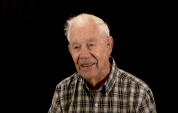4:41 | He had some radio experience when he enlisted in the Navy, so Jake Wilson was selected for Radar school and went to a spacial boot camp for technicians. More math instead of more push ups. Then he qualified for a new special Radar countermeasures program. (This interview made possible with the support of MSG RONALD M. CAREY, U.S.A. (RET).)
Keywords : Jacob Jake Wilson Madison GA Athens GA radio Macon GA Charleston SC radar electronics Silver Spring MD math Corpus Christi TX Ward Island TX radar countermeasures Alexandria VA jamming

Jake Wilson was a specialist in Radar countermeasures assigned to the South West Pacific. A special unit named Section 22, made up of Americans and Australians from all the military branches, was formed to train Allied radar operators in how to recognize and resist any Japanese efforts to use this technology. (This interview made possible with the support of MSG RONALD M. CAREY, U.S.A. (RET).)
Jake Wilson was part of a team that went into South West Pacific airfields as soon as they were established to train radar operators in radar countermeasures. Sometimes, this put him in danger from Japanese bombing and he recalls a couple of incidents here. (This interview made possible with the support of MSG RONALD M. CAREY, U.S.A. (RET).)
Radar countermeasures technician Jake Wilson was stationed for a while at an airfield in the Philippines where there were many crashes. Maybe it was the volume of flights, but for some reason, it kept happening and he describes one of the worst here. This was after he lost his team leader in a crash away from the base. (This interview made possible with the support of MSG RONALD M. CAREY, U.S.A. (RET).)
Radar jamming was a new technology and Jake Wilson was busy installing jamming equipment on B-24's engaged in bombing runs near the end of the war. He also made patrol flights over the South West Pacific, trying to locate and analyze Japanese radar operations. He finally qualified for a 30 day leave home and while he was there, the war ended. (This interview made possible with the support of MSG RONALD M. CAREY, U.S.A. (RET).)
How were the Japanese locating us with their radar from 200 miles away, far past radar range? Radar countermeasures technician Jake Wilson tells how he figured that one out. He also tells why the popular idea that the Japanese were copiers of technology, not innovators, was an erroneous idea. (This interview made possible with the support of MSG RONALD M. CAREY, U.S.A. (RET).)
The professors at the University of Sydney helped Radar countermeasures technician Jake Wilson build one of the first Radar jamming transmitters used in the Pacific. They tried different ways of obscuring the signal until they settled on noise modulation. (This interview made possible with the support of MSG RONALD M. CAREY, U.S.A. (RET).)
Jake Wilson recalls his time in the special boot camp for radar technicians. Unlike other boot camps, there was a lot of math study. At the next training level, it got even more difficult and 60% of the men were washed out. (This interview made possible with the support of MSG RONALD M. CAREY, U.S.A. (RET).)
Jake Wilson was based in Australia for a time and he recalls the taxing train ride between Brisbane and Sydney. When a yeoman in charge of transportation refused them air travel, that didn't sit well with the team members. (This interview made possible with the support of MSG RONALD M. CAREY, U.S.A. (RET).)